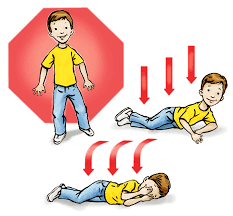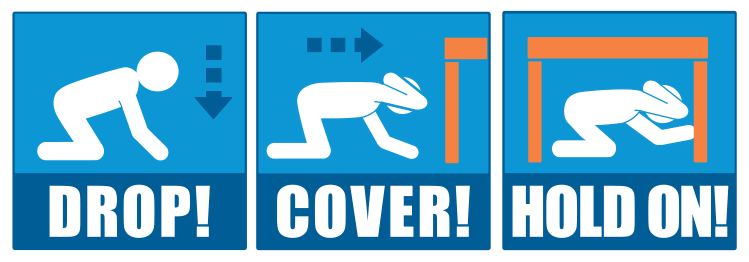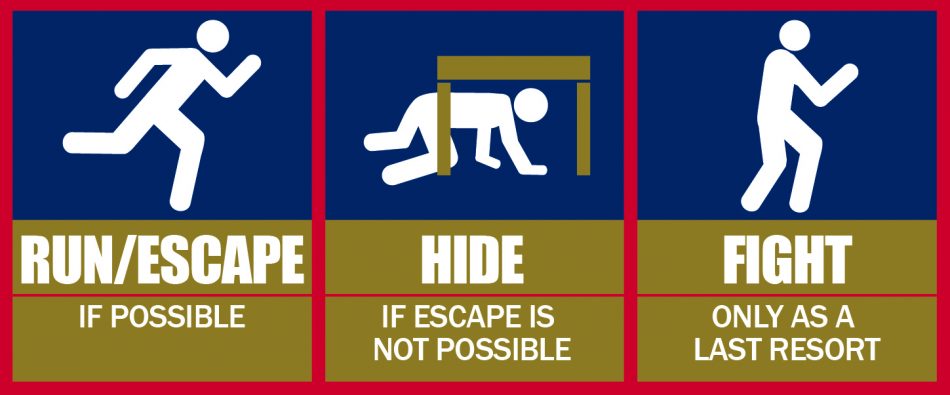Protective Actions
THE POINT
If you don’t know how to survive the disaster, then the rest of your plans don’t really matter.
You need to know the actions taken to protect yourself or others from the initial impact of a hazardous incident.
DO THIS
- Learn what potential hazards are possible in your area
- Play "what if" with family members to brainstorm different emergency scenarios with those hazards
- Learn the protective actions that apply to the potential hazards and possible scenarios
- Teach the protective actions to your family members and practice them often
Emergency preparedness is knowing what to do and having the resources, willingness, and ability to safely and appropriately respond to an emergency when it really matters. Many people think preparedness only involves storing water and dried food in a closet or basement. Maybe by having enough first aid supplies, batteries, flashlights, military rations, generators, and bottles of ketchup, your family will survive any disaster.
Having a storage of life preserving supplies is essential in the aftermath of an incident, but if you don’t know how to survive the initial impact of a disaster, then the rest of your plans don’t really matter.
Protective Actions
Protective actions can't be purchased and can't be stored on a shelf. They are a vital part of emergency preparedness though they might only be used for a few seconds or minutes. Once you find them, they need to be learned, practiced, and regularly reviewed.
What are they?
Protective actions are the immediate actions taken to protect yourself and others from the initial impact of a hazardous incident.

Stop, Drop, and Roll
One example that many of us learned in elementary school is the protective action for if your clothes are on fire -- STOP, DROP, and ROLL. The idea being that you 1) Stop what you are doing. 2) Drop to the ground. 3) Cover your face with your hands, keep your legs straight and roll over and over, back and forth, to put the flames completely out. Then go get help from an adult.
Know Potential Hazards
The first step in learning protective actions is to find out what potential hazards exist where you live and work, and what dangers may be encountered if the hazard becomes an emergency situation. These could include things like severe winter storms, high winds, lightning, wildfires, structure fires, floods, earthquakes, and more. Ask your local city or county emergency management office about hazards in your area. Be Ready Utah and our parent agency, the Utah Division of Emergency Management, both have lists of hazards that may impact our state on our websites. Click the links below for more information.
Play "What If?"
Discuss and brainstorm with your household members different scenarios that you could face if impacted by any of the hazards you learned about.

Get low and go! Once out, stay out!
Think something like "what if" you are at home and you hear a smoke alarm? The proper protective action is not stop, drop, and roll, but GET LOW and GO! And ONCE OUT, STAY OUT! Modern construction means you only have about two minutes to escape a house fire. The temperature at eye level can quickly rise to several hundred degrees Fahrenheit. Thick, black, toxic smoke will also be filling the room. You need to "get low," below the level of the heat, fumes, and smoke, on your hands and knees, or lower, to quickly "go" by crawling to the nearest exit.
Once you are out of the building, you must "stay out." Don't go back in for valuables, pets, or even other people. You do not have the training or the necessary equipment to survive in a burning building.
In addition to knowing the correct protective actions for a house fire, make a plan to safely escape from each room of your house and where to meet after everyone is out.
Some other fire "what if" scenarios could be:
- What if there is a fire in the microwave or oven? Protective Action: Turn off the power and/or unplug the appliance. Keep the door closed until the fire is out and the inside cools down. Don't open the door right away.
-
What if there is a fire on the stove? Protective Action: If it is small enough, cover it with a lid, a fire blanket, or put it out with a class K fire extinguisher. Turn off the heat source and let it cool.
- What if I'm in a closed room and the smoke alarm goes off? Protective Action: Touch the door with the back of your hand to feel if the door is warm. If not, open the door, get low, and go. If it is warm, put towels, clothing, or something else - preferably wet - at the base of the door to prevent smoke from coming in and go out through a secondary exit like a window. Have a fire escape ladders beforehand in rooms on upper floors as part of your emergency evacuation plans.
- Others?
Brainstorm as many "what if" scenarios as you can for each potential hazard you are likely to face. Go through one hazard at a time and see how many you can think of.
Research and Determine Solutions
Some hazards and scenarios may have intuitive solutions as to what the proper protective actions may be. Others, like earthquakes, have a lot of information, outdated information and misinformation that need to be learned and/or corrected.
 So, "what if" the ground starts to shake? Research shows that according to the most recent information from seismologists found on Earthquakes.Utah.gov, because of the high standards of building codes and the quality of construction in our architecture, most injuries and deaths occur due to falling objects within the building, not structures. It also shows that DROP, COVER, and HOLD ON is the correct protective action.
So, "what if" the ground starts to shake? Research shows that according to the most recent information from seismologists found on Earthquakes.Utah.gov, because of the high standards of building codes and the quality of construction in our architecture, most injuries and deaths occur due to falling objects within the building, not structures. It also shows that DROP, COVER, and HOLD ON is the correct protective action.
- "Drop" to the ground so that the aggressive shaking of the quake doesn't throw you to the ground. You are less likely to be injured of you put yourself on the ground. Do not try to exit the building. Many facades on buildings are just decorative and can easily crumble and fall. You are safer to stay indoors until the shaking stops.
- "Cover" your head, the most important part of your body, with your arms, then crawl to the nearest cover UNDER a table, desk, or other sturdy structure.
- "Hold on" to that cover until the shaking stops. The violent shaking can move you and your cover away from each other unless you hold on firmly.
Research links to information on earthquake protective actions and preparedness:
Let's brainstorm some earthquake scenarios:
- What if the ground starts to shake and I'm in a wheel chair? Protective Action: According to Ready.gov, LOCK, COVER, and, HOLD ON. Lock the chair's wheels so it won't roll, cover your head with your arms or anything solid, and I hold on to your chair.
- What if the ground starts to shake and I'm driving? Protective Action: According to EarthquakeCountry.org, quickly pull over to the side of the road, making sure you are not underneath anything that could fall on you. Set the parking break and wait for the shaking to stop.
-

Stay in bed, cover your head.
What if the ground starts to shake and I'm in bed? Protective Action: According to ShakeOut.org, stay in bed, lying face down and cover your head with a pillow and both hands. Stay there until the shaking stops.
- What others can you come up with? Can you find the proper protective actions?
Here are some additional links to lists of hazards and associated protective actions that are great additions to your protective action and preparedness references:
Teach, Practice, and Revise Plans
 As you learn the protective actions for different hazards and different scenarios within those hazards, it is important to teach them to those you care about at home, at work, and in your neighborhood. Not every protective action has an easy to memorize phrase. Be sure to teach which protective actions are for which hazard and why. Remember that only talking about a protective action is not as effective as physically demonstrating and then practicing the action together. The point is to remember these protective actions quickly and to act on them immediately when it matters most.
As you learn the protective actions for different hazards and different scenarios within those hazards, it is important to teach them to those you care about at home, at work, and in your neighborhood. Not every protective action has an easy to memorize phrase. Be sure to teach which protective actions are for which hazard and why. Remember that only talking about a protective action is not as effective as physically demonstrating and then practicing the action together. The point is to remember these protective actions quickly and to act on them immediately when it matters most.
As you practice the protective actions together you may find that some will need to be modified to meet physical or mental limitations. Be patient and do the best you can. All plans need revisions when they are put into practice. Help children learn by making emergency drills a game. See who can act out the correct protective action by calling out different scenarios.
Here is a list of some other hazards and situations and their protective actions:
Active shooter – Run, Hide, Fight

Avalanche - Get the Gear, Get the Training, Get the Forecast, Get the Picture, Get Out of Harms Way. See this link to FEMA's list of protective actions if you are caught in an avalanche.
Bleeding - Stop The Bleed

Cybersecurity: Stop, Think, Connect
Flood waters – Turn Around Don’t Drown
Lightning – When Thunder Roars, Go Indoors (CDC, NOAA)
Nuclear and Radiological Incident - Get Inside, Stay Inside, Stay Tuned

Pandemic – Sanitize Often, Social Distance
Stand-by alert – Listen to EAS
